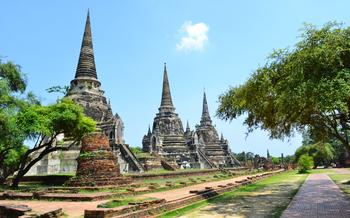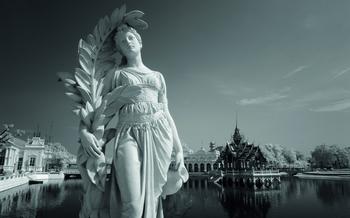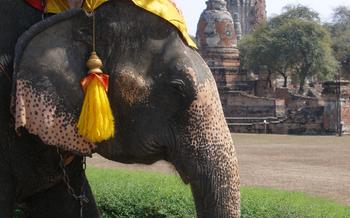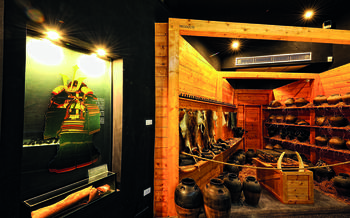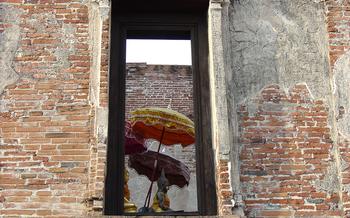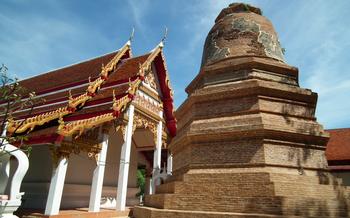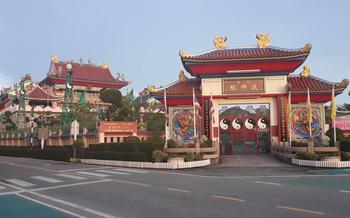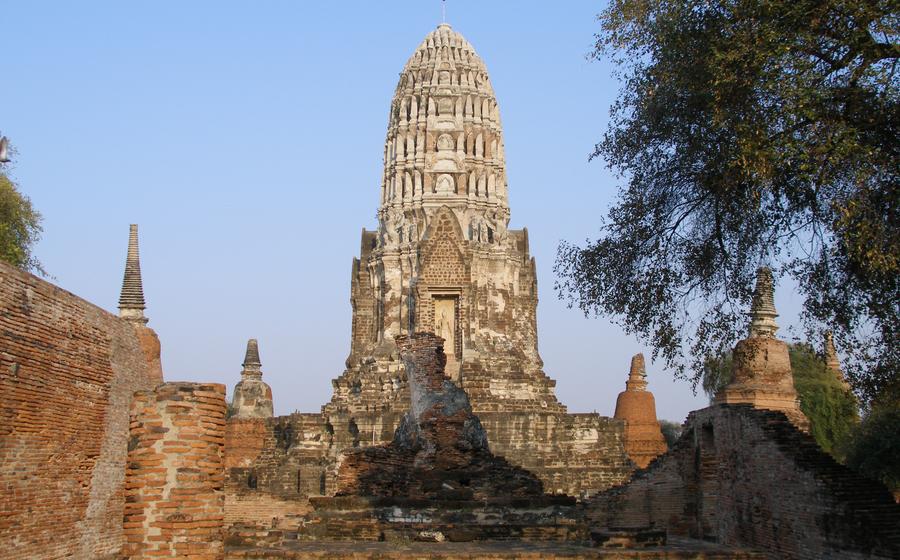
Wat Phra Ram
- The Ruins of Ayutthaya: A Glimpse into the Past
- Wat Mahathat: A Symbol of Royal Power and Prestige
- Wat Phra Si Sanphet: The Royal Temple of the Siamese Kings
- Wat Phra Ram: An Iconic Temple Complex
- History of Wat Phra Ram
- Architectural Highlights
- Exploring the Temple Grounds
- Wat Phra Ram's Importance
- The Legend of King Ramathibodi I
- Other Temples in Ayutthaya
- What to Wear and Bring
- Photography Tips
- Local Cuisine and Dining Options
- Ayutthaya Night Market: A Culinary and Cultural Extravaganza
- Insider Tip: The Hidden Sanctuary
- Insider Tip: Unveiling the Forgotten Sanctuary
The Ruins of Ayutthaya: A Glimpse into the Past
Ayutthaya, once the glorious capital of the Siamese kingdom, now stands as a testament to the grandeur and resilience of a bygone era. Its ruins, scattered throughout the Ayutthaya Historical Park, offer a glimpse into the opulence and artistry of the ancient Siamese civilization. Explore crumbling temples and palaces, marveling at the intricate carvings and architectural feats that have withstood the ravages of time. Wander amidst the serene atmosphere, imagining the bustling streets and vibrant life that once filled this extraordinary city.
Wat Mahathat: A Symbol of Royal Power and Prestige
Among the many ruins of Ayutthaya, Wat Mahathat stands as a poignant reminder of the kingdom's power and grandeur. Its towering prang, once the tallest structure in the city, dominates the skyline, while its intricately carved Buddha heads, peeking out from the tree roots, have become iconic symbols of Ayutthaya's rich history. Explore the temple's vast courtyards, admiring the remnants of stupas, viharns, and ubosots, each telling a story of the kingdom's religious devotion and architectural prowess.
Wat Phra Si Sanphet: The Royal Temple of the Siamese Kings
Wat Phra Si Sanphet, located within the Grand Palace complex, was the most important temple in the Ayutthaya Kingdom, serving as the royal chapel for the Siamese kings. Its three towering prangs, symbolizing the Buddhist Trinity, once gleamed with gold and precious stones, reflecting the kingdom's immense wealth and power. Explore the temple's ruins, imagining the grand ceremonies and processions that once took place within its sacred walls, and marvel at the exquisite craftsmanship that adorned every corner of this royal sanctuary.
Wat Phra Ram: An Iconic Temple Complex
Within the Ayutthaya Historical Park, one of the most captivating temple complexes is Wat Phra Ram. This iconic site showcases the grandeur and architectural prowess of the ancient Siamese kingdom. Explore the remaining structures, including the impressive prang, stupas, and Buddha images, and admire the unique architectural style that blends Khmer and Thai influences. Feel the spiritual essence and tranquility that permeate the temple grounds, transporting you back to a time when Ayutthaya was the thriving capital of Siam.
History of Wat Phra Ram
Wat Phra Ram's history is closely intertwined with the rise and fall of the Ayutthaya Kingdom. Constructed in the 14th century during the reign of King Ramathibodi I, the temple initially served as a royal temple and a residence for the king's son. Its strategic location within the city made it a significant religious and administrative center during the Ayutthaya period. However, the temple's fate took a tragic turn in the 18th century when the Burmese invaded and partially destroyed Ayutthaya. The once-magnificent temple suffered extensive damage, leaving behind the ruins that we see today. Despite its dilapidated state, Wat Phra Ram remains a testament to the grandeur and opulence of the Ayutthaya Kingdom and continues to captivate visitors with its historical and architectural significance.
Architectural Highlights
Wat Phra Ram boasts a captivating array of architectural elements that showcase the artistic brilliance of the Ayutthaya period. The towering prang, a defining feature of Khmer architecture, rises majestically over 35 meters in height. Its grandeur is further accentuated by the intricate carvings that adorn its surface, depicting scenes from Buddhist mythology and the daily lives of the ancient Siamese people.
Exquisitely carved Buddha images, a hallmark of Ayutthaya art, grace the temple grounds. These serene and sacred figures exude a sense of tranquility and spirituality, inviting visitors to contemplate the teachings of the Buddha. The bas-reliefs and decorative elements found throughout the temple are equally impressive, showcasing the exceptional craftsmanship and attention to detail that characterized Ayutthaya's artistic legacy.
The remaining stupas, once part of a larger ensemble, stand as silent witnesses to the temple's former glory. These sacred structures, with their intricate designs and symbolic significance, evoke a sense of awe and reverence. Together, these architectural elements create a harmonious ensemble that transports visitors back to the grandeur and opulence of the Ayutthaya Kingdom.
Exploring the Temple Grounds
As you enter the ancient domain of Wat Phra Ram, let the tranquility of the temple grounds envelop you. Wander through the serene courtyards, where weathered structures and lush greenery create a captivating tapestry of history and nature. Discover hidden corners and alcoves, revealing remnants of past splendor that speak of the temple's glorious heritage. Take a moment to sit and contemplate amidst the peaceful surroundings, absorbing the spiritual essence that permeates the air. Remember to respect the sacred nature of the site and observe appropriate conduct while exploring, honoring the deep reverence that this temple holds for the Thai people.
Wat Phra Ram's Importance
Wat Phra Ram stands as a testament to the architectural brilliance of the Ayutthaya Kingdom, showcasing intricate designs and craftsmanship that have withstood the ravages of time. The temple's historical significance extends beyond its architectural value, as it provides a glimpse into the religious beliefs and practices of the ancient Siamese people. The presence of Buddha images, stupas, and other sacred symbols reflects the deep devotion and reverence for Buddhism during the Ayutthaya period. Furthermore, Wat Phra Ram offers insights into the grandeur and opulence of the royal court, serving as a reminder of the kingdom's wealth and power. The temple's existence serves as a poignant reminder of the impermanence of all worldly possessions, echoing the Buddhist principle of anicca, or the transient nature of existence.
The Legend of King Ramathibodi I
The founding of Ayutthaya is steeped in myth and legend, intertwined with the story of King Ramathibodi I, the kingdom's first ruler. According to legend, King Ramathibodi I, then known as Prince Uthong, was on a hunting expedition when he encountered a white elephant, a symbol of purity and divine power in Thai culture. The elephant is said to have led him to the site where Ayutthaya would be established.
This encounter with the white elephant is seen as a divine sign, legitimizing King Ramathibodi I's claim to the throne and the establishment of a new kingdom. The white elephant became a symbol of the Ayutthaya Kingdom, appearing on the royal seal and serving as a reminder of the kingdom's divine mandate to rule.
The legend of King Ramathibodi I's encounter with the white elephant highlights the interconnectedness of myth, history, and religion in shaping Thailand's identity. It reflects the deep-rooted belief in the divine nature of kingship and the importance of auspicious signs in Thai culture.
Other Temples in Ayutthaya
Wat Phra Ram is just one of many awe-inspiring temples within the Ayutthaya Historical Park. To fully appreciate the grandeur of the ancient city, visitors should consider exploring other significant temples in the park.
Wat Mahathat: Known for its iconic prang, which has become a symbol of Ayutthaya, Wat Mahathat is a must-visit for its historical and architectural significance. The reclining Buddha image within the temple's grounds is a particularly striking feature.
Wat Phra Si Sanphet: Once the royal temple of the Ayutthaya Kingdom, Wat Phra Si Sanphet boasts three majestic chedis, each representing a different king. The intricate carvings and decorative elements showcase the artistic prowess of the Ayutthaya period.
Wat Chaiwatthanaram: Situated on the west bank of the Chao Phraya River, Wat Chaiwatthanaram is renowned for its unique architectural style, blending Khmer and Thai influences. The temple's prang and surrounding stupas create a stunning silhouette against the backdrop of the river.
Wat Yai Chai Mongkhon: This temple is famous for its giant seated Buddha image, which stands over 12 meters tall. The serene atmosphere and tranquil surroundings make Wat Yai Chai Mongkhon a popular spot for meditation and reflection.
Wat Lokayasutharam: Located a short distance from the Ayutthaya Historical Park, Wat Lokayasutharam is home to a large reclining Buddha image, measuring over 42 meters in length. The intricate carvings and serene atmosphere make this temple a hidden gem worth exploring.
When planning an itinerary for exploring the Ayutthaya Historical Park, visitors should consider the following tips:
- Start early to avoid the midday heat and crowds.
- Rent a bicycle or hire a tuk-tuk to easily navigate between temples.
- Bring water, sunscreen, and a hat to stay hydrated and protected from the sun.
- Respect the sacred nature of the temples and dress appropriately.
- Allocate at least half a day to fully explore the main temples and soak in the atmosphere of the historical park.
What to Wear and Bring
When visiting Wat Phra Ram and other sacred temple sites in Ayutthaya, it is essential to dress appropriately to show respect for the religious significance of the location. Opt for modest attire that covers your shoulders and knees, avoiding revealing or overly casual clothing. Comfortable footwear is recommended, as you will be doing a lot of walking on uneven surfaces.
The tropical sun in Thailand can be intense, so remember to bring water, sunscreen, and a hat to protect yourself from the heat. It is also advisable to carry a small backpack or bag to store your belongings and keep your hands free while exploring the temple grounds.
Remember to be mindful of your behavior and maintain a respectful demeanor while visiting the temple. Avoid loud noises, refrain from touching or climbing on the ruins, and be considerate of other visitors who may be seeking a tranquil and spiritual experience.
Photography Tips
Capturing the beauty and grandeur of Wat Phra Ram through photography is a rewarding experience. Here are some tips to help you take stunning photographs:
-
Early Morning and Late Afternoon Light: The best lighting conditions for photography at Wat Phra Ram are during the early morning and late afternoon hours. The soft, warm light during these times enhances the temple's intricate details and creates a magical atmosphere.
-
Experiment with Angles and Perspectives: Don't limit yourself to straightforward shots. Experiment with different angles and perspectives to create unique and memorable images. Try capturing the temple from below to emphasize its towering height or shooting through the archways to frame the ruins in a captivating way.
-
Focus on Details: Wat Phra Ram is adorned with exquisite carvings, sculptures, and bas-reliefs. Take your time to focus on these details, capturing the intricate craftsmanship and artistry that went into creating them. Close-up shots of these elements can reveal hidden stories and add depth to your photographs.
-
Respect the Tranquility: While taking photos, be mindful of the temple's sacred nature and the serenity of the surroundings. Avoid using tripods or flash photography, as they can be disruptive to other visitors and detract from the spiritual atmosphere of the site.
Local Cuisine and Dining Options
Ayutthaya's culinary scene is a delightful blend of traditional Thai flavors and local specialties. Visitors can embark on a culinary adventure by sampling the delectable dishes offered by the city's many restaurants, food stalls, and night markets.
For an authentic Thai experience, try the popular Pad Thai, a stir-fried rice noodle dish with a sweet and tangy sauce, or Tom Yum Goong, a spicy and sour prawn soup. Khao Soi, a coconut-based curry noodle soup, is another must-try dish that combines rich flavors and textures.
Ayutthaya is also known for its delicious street food, which offers a wide variety of snacks and meals at affordable prices. From grilled meats and seafood to fresh fruits and sweets, there's something for every palate to enjoy. Be sure to try the Roti Sai Mai, a crispy crepe filled with sweet or savory fillings, or the Lod Chong, a refreshing shaved ice dessert with coconut milk and colorful jelly strips.
For a lively and cultural dining experience, visit the Ayutthaya Night Market. This bustling market comes alive in the evening, offering a myriad of food stalls, souvenir shops, and live music performances. Here, you can indulge in local delicacies such as Khanom Buang, a crispy coconut pancake filled with sweet custard, or Sai Oua, a grilled pork sausage flavored with lemongrass and kaffir lime leaves.
Embrace the local culinary experience and savor the diverse flavors of Ayutthaya's cuisine. From street food stalls to night markets, there are culinary delights waiting to be discovered at every corner.
Ayutthaya Night Market: A Culinary and Cultural Extravaganza
After exploring the ancient ruins of Ayutthaya, immerse yourself in the vibrant energy of the Ayutthaya Night Market. Located in the heart of the city, this bustling market comes alive as the sun sets, offering a unique blend of local cuisine, live music, and cultural performances.
As you stroll through the narrow alleys illuminated by colorful lanterns, the tantalizing aromas of grilled meats, spicy curries, and sweet desserts fill the air. Indulge in the culinary delights of Thailand, from mouthwatering pad thai and crispy roti sai mai to exotic tropical fruits and refreshing sugarcane juice.
The night market is not just about food; it's also a showcase of Thai culture and traditions. Local artisans display their handmade crafts, from intricate silver jewelry and colorful textiles to hand-painted pottery and carved wooden sculptures. You can also enjoy live music performances, traditional dance shows, and even Muay Thai demonstrations.
Take your time to explore the market's many stalls, soak in the vibrant atmosphere, and engage with the friendly locals. Whether you're looking for a delicious meal, a unique souvenir, or simply a fun night out, the Ayutthaya Night Market is an experience not to be missed.
Insider Tip: The Hidden Sanctuary
Amidst the bustling crowds of Wat Phra Ram, there lies a hidden sanctuary where you can find peace and tranquility. Tucked away in a secluded corner of the temple complex, the "Secret Garden" is a serene oasis adorned with lush greenery, colorful flowers, and a tranquil pond.
This hidden gem is the perfect place to escape the hustle and bustle of the temple grounds and enjoy a moment of contemplation. As you wander through the garden, take in the sights and sounds of nature, and let the serenity of the surroundings wash away your worries.
To find the Secret Garden, look for a small path leading off from the main courtyard. Follow the path until you reach a wooden gate, which will lead you into this hidden sanctuary. Be sure to respect the sacred nature of the temple and maintain a respectful demeanor while exploring this tranquil space.
Insider Tip: Unveiling the Forgotten Sanctuary
Tucked away amidst the sprawling ruins of Wat Phra Ram lies a hidden gem that often goes unnoticed by visitors. Beyond the main courtyards and towering prangs, a secluded sanctuary awaits those who venture off the beaten path. Follow a narrow, overgrown trail, and you will stumble upon a forgotten shrine, nestled amidst lush vegetation and ancient trees. Here, you can find a well-preserved Buddha image, radiating serenity and evoking a sense of peace. Take a moment to sit in silence, surrounded by the tranquil atmosphere, and appreciate the hidden beauty that this secluded spot offers.
